In a world increasingly shaped by shifting climate patterns, rapid globalization, and polarized public health decisions, it’s no surprise that some long-dormant diseases are making a comeback. Once thought to be relics of history, these illnesses are now reappearing in hospitals, schools, and communities across the globe. The reasons behind this resurgence are complex, but many can be tied directly to human behavior and societal trends in 2025.
From vaccine hesitancy to urban overcrowding, the resurgence of certain diseases is raising red flags among epidemiologists and public health experts alike.
Measles Is Back—And Vaccine Hesitancy Is to Blame
Once nearly eradicated in many parts of the world, measles is now surging again, thanks largely to the growing influence of anti-vaccine rhetoric. Social media has played a key role in spreading misinformation, undermining public confidence in immunization programs.
In 2025, online conspiracy communities have grown more sophisticated, targeting younger audiences with polished videos and influencer endorsements that cast doubt on vaccine safety. The result has been a sharp decline in childhood immunization rates in various regions, especially in urban centers where mistrust of institutions runs high. This drop in herd immunity has given measles the perfect opportunity to thrive once more.
Tuberculosis Is Creeping Back in Crowded Cities
Tuberculosis, often assumed to be a problem of the past or confined to low-income nations, is beginning to reappear in major metropolitan areas. The housing crisis and economic inequality in 2025 have created overcrowded living conditions that allow the bacteria to spread more easily.
Compounding the issue is a surge in antibiotic-resistant strains of TB, making treatment more difficult and lengthy than ever before. Many urban hospitals are now struggling with a rise in undiagnosed or late-diagnosed TB cases, especially among the unhoused population. Public health campaigns have started to refocus attention on TB screening, but stigma and limited access to care continue to hinder progress.
Whooping Cough Is Resurging in Suburban Schools
Pertussis, more commonly known as whooping cough, has seen a resurgence in recent years, particularly in suburban school districts. Much like the measles outbreak, this trend is linked to declining vaccination rates and misinformation campaigns targeting parents.
The cyclical nature of whooping cough outbreaks has been exacerbated by waning immunity in older children and adults who were vaccinated years ago. Schools have become hotbeds for transmission, with students and staff spreading the bacteria before symptoms even appear. Health authorities are urging booster shots and tighter immunization enforcement, but political pushback in some regions has slowed those efforts.
Syphilis Is on the Rise Again in the Digital Dating Era
The dramatic rise of syphilis cases has caught many by surprise, especially given decades of declining numbers. Experts tie this resurgence to changing patterns in dating and sexual behavior fueled by dating apps and a culture of casual encounters.
In 2025, public health education on safe sex practices has struggled to keep up with these fast-paced shifts in social norms. Meanwhile, stigma and lack of awareness around testing contribute to the spread of untreated cases, particularly in young adults. The disease, which can be easily cured in its early stages, is now reemerging with complications rarely seen in the modern era.
Malaria Is Expanding Its Reach Due to Climate Change
Once confined to tropical regions, malaria is now appearing in areas that previously had no history of the disease. Climate change is playing a pivotal role by expanding the habitat of the mosquitoes that transmit malaria, allowing them to thrive in new, warmer zones.
In 2025, cases have been reported in parts of southern Europe and even the southern United States—areas that previously had little to no risk. Health systems in these regions are unprepared for vector control and rapid diagnosis, leading to delays in treatment. As global temperatures continue to rise, experts warn that malaria’s reach will only extend further unless aggressive preventative measures are taken.
Mumps Is Hitting College Campuses Once Again
Another disease making a quiet comeback in 2025 is mumps, particularly on college and university campuses. These environments, filled with close-contact socializing, shared housing, and communal dining, are ideal for the virus to spread. Although the MMR vaccine covers mumps, its effectiveness can wane over time, and many young adults have not received booster doses. Outbreaks have been reported in multiple countries, prompting some institutions to reintroduce strict vaccination policies and temporary campus lockdowns. The resurgence is a reminder that childhood vaccines may need reinforcements later in life to remain effective.
Leprosy Isn’t Gone—It’s Just Been Ignored
Leprosy, also known as Hansen’s disease, never fully disappeared but has flown under the radar due to its relatively low incidence. However, 2025 has seen a slight uptick in cases in regions with poor healthcare access and underfunded disease surveillance.
Migration patterns, combined with weakened health infrastructure in some developing nations, have allowed the disease to persist in pockets. Additionally, a lack of awareness among healthcare workers means cases are sometimes missed or misdiagnosed. With early treatment still effective, experts stress the importance of education and routine screenings to keep leprosy from becoming a broader concern.
Dengue Fever Is Thriving in Urbanized Environments
Dengue fever, another mosquito-borne illness, has exploded in frequency and range in 2025. Rapid urbanization without adequate sanitation or drainage infrastructure has created perfect breeding grounds for the Aedes mosquito. International travel and trade have also enabled the virus to spread more easily between continents. In cities like Mumbai, São Paulo, and even parts of Florida, outbreaks are becoming more frequent and intense. Governments are ramping up mosquito control efforts, but inconsistent policies and limited resources are hampering progress.
Hepatitis A Is Spreading Through Contaminated Food and Water
Hepatitis A has made an unexpected comeback, driven largely by food supply chain issues and insufficient sanitation. Outbreaks in 2025 have been traced back to contaminated produce and food-handling practices in both restaurants and industrial agriculture settings. The illness, which spreads through fecal-oral transmission, has disproportionately affected unhoused populations and communities lacking clean water. While there is a vaccine, many adults have not received it, leaving them vulnerable in the event of an outbreak. Increased awareness and better food safety regulations are urgently needed to curb its spread.
Scarlet Fever Is No Longer Just a Historical Footnote
Once feared in the 19th century, scarlet fever is now making its presence known again in classrooms and pediatric wards. Caused by the same bacteria responsible for strep throat, this illness was largely under control until recently. In 2025, evolving strains and a decline in routine checkups during the pandemic years have allowed it to return. While treatable with antibiotics, delayed diagnosis can lead to complications. Rising case numbers are prompting new conversations about improving diagnostic training among primary care providers.
A Wake-Up Call for Public Health in 2025
These disease resurgences are more than just public health curiosities—they’re a warning sign that the systems we rely on to keep us safe are vulnerable to the pressures of modern life. Whether it’s social media misinformation, environmental change, or the erosion of global trust in science, 2025 is showing just how interconnected health trends truly are. To reverse these dangerous patterns, coordinated global action, renewed investment in public health infrastructure, and improved communication are all essential. Communities must also play a proactive role in demanding accountability, transparency, and evidence-based policies.
What diseases have you noticed making a comeback—or are you concerned about one not mentioned here? Submit your thoughts and comments below in order to join the conversation.
Read More
10 Health Supplements That Doctors Want You To Stop Taking Immediately
8 “Common” Health Problems That Are Really Silent Killers


